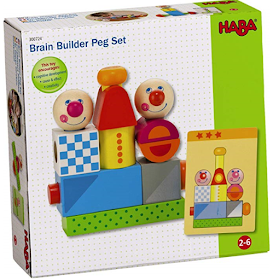 |
| HABA Brain Builder Peg Set - 3 levels of difficulty |
In the box: 18 wooden pieces, 20 pattern cards
I'm always on the lookout for construction-type sets with pattern cards, so when I saw that this HABA Brain Builder Peg Set was $20 cheaper than another one I had been eyeing by another manufacturer, I bought it. So many skills can be addressed with these types of sets and because it already comes with 20 pattern cards that are graded for difficulty, it's less work for me. Plus, the kids I work with tend to like these kinds of games/puzzles.
Haba is a German company and one of my favorite manufacturers because their pieces are typically good quality and stand up well over time. The pieces in this set are wooden, smooth, brightly painted, and come in a variety of shapes.
There are 20 pattern cards that are divided into three levels of difficulty. The cards are easy to sort into levels because each level is a different color (see image below) and each card has one, two or three stars at the top to indicate the level of difficulty. There are 8 level 1 cards, 6 level 2 cards, and 5 level 3.
I read the Amazon reviews before purchasing and several people wished that the pattern cards were of a heavier material or laminated. They are plastic coated, and although they are not a heavy card stock, they feel fine to me. If a person wanted to laminate them, they always could, but I don't feel a need for it. The front of each card shows the finished model, and the back of each card shows how the pieces are put together. I will put images below to show what I mean, along with a sample from each level.
 |
| Levels 1, 2 and 3. Fronts of cards. |
 |
| Backs of the above 3 cards with solutions. |
If you are new to my blog and also like these types of games, click HERE
to go to a post with a long list of other activities of this type that I
have blogged about. If you are interested in other activities of this type, check out my post What's in Your Therapy Box? Pattern Block Edition.
Try this:
- Start by playing, and/or examining the pieces without building any models so that the individual can get acquainted with the different shapes and views from different perspectives.
- Start with the necessary pieces lying on the table, already in the correct orientation, for beginners. As the individual improves, turn the necessary pieces so that they will need to be flipped and oriented, pile the pieces on the table so that some are partially covered or behind others, and/or add additional unnecessary pieces to sort through. Work on a variety of visual perceptual skills at the same time.
- Hand the individual a block at a time to build if they cannot look at a finished model and tell where to start or how to proceed.
- Try using the work "stack" if the individual wants to start at the top and build down. This has worked for me.
- Orient and place a piece for the individual as he watches, if he is having difficulty building. Then pick it back up, flip or turn it, and give it back to him to try again.
- Ask the individual "Is that correct?" if a mistake has been made and allow him time to spot the error and correct it before jumping in to help. Errors left uncorrected til the end may result in not enough pieces, an unstable structure and unnecessary frustration.
- Hand the individual each piece as he needs it in the incorrect orientation. Ask him to turn it in-hand to position it for placement.
- Find all the pieces for a model ahead of time. Place only those pieces and the card in front of the child. This may decrease frustration that might be added by working on too many things at once.
- Push the first piece or two toward the individual if he is having trouble getting started. Stop assisting as soon as you see he is ready to go it alone.
- Show the individual the back of the card after the model is completed. It will not be the view you will see because parts of pieces will be hidden if they are inside other pieces, but it will give another perspective.
- Place the pieces into a bag that you can't see through (or Ned's Head) and ask the individual to put his hand in and feel for each piece as he needs it to build.
- Use consistent positional and relational language as you work.
- Build from the back of the cards.
- Work on manual dexterity, in-hand manipulation, visual discrimination, visual closure, visual form constancy, spatial relations/position in space, figure ground, eye-hand coordination, problem solving skills, logic, executive functioning skills, process skills, play and leisure exploration and participation
If you are interested in purchasing this item or just want more information, click on the image below.



No comments:
Post a Comment
Thank you for taking the time to comment.